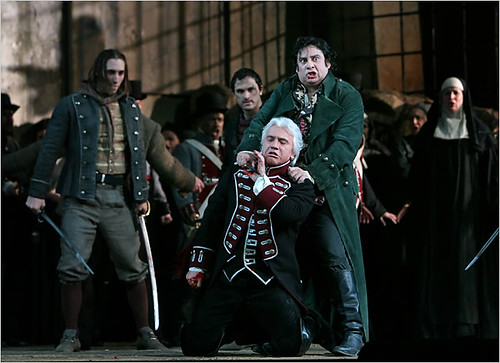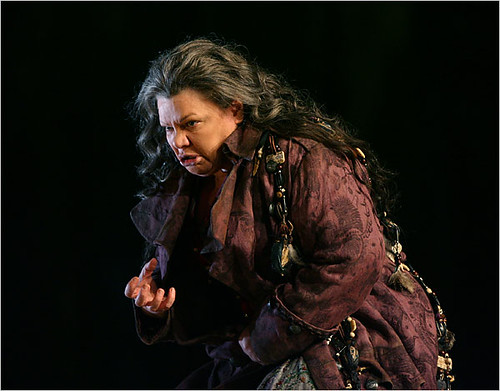Eis o veredicto do The New York Times sobre a produção de Il Trovatore, agora estreada no Met:
«Actually, “double curse” was the way Peter Gelb, the general manager of the Metropolitan Opera, referred to the company’s seeming inability to present a decent production of Verdi’s “Trovatore” in its laughably inept last two tries, in 1987 and 2000. But on Monday night the Met introduced a new staging by the Scottish director David McVicar, in his company debut. And with this “Trovatore” the Met knew what it was getting: the production was introduced at the Lyric Opera of Chicago in 2006.
No matter. It is new to the Met, and it works. This may not be the most imaginative or visually striking “Trovatore.” But it is a clear-headed, psychologically insightful and fluid staging.
(...)
Rather than encumbering the opera with a heavy-handed concept, Mr. McVicar simply updates the story from Spain in 1409 to the early 19th century, during the Spanish War of Independence, which makes the factional strife seem more contemporary. He and his creative team — including the set designer Charles Edwards and the costume designer Brigitte Reiffenstuel, also making their Met debuts — draw inspiration from “The Disasters of War,” Goya’s series of etchings. And the Goya imagery gives the production a consistent and harrowing look.
A tall, looming unit set rotates slowly to conjure different scenes: the gray wall of a castle, crossed diagonally by an ominous set of stairs; the secluded courtyard of a cloister; rocky cliffs to evoke both a Gypsy encampment and a dungeon where Manrico and Azucena await their deaths. In the background we see the charred bodies of victims still bound to stakes.
(...)
Though there are no real dances in “Il Trovatore,” the production team includes the choreographer Leah Hausman, in her Met debut, and she surely helped bring physical intricacy to the crowd scenes.»
Se em matéria de encenação a coisa não correu mal - a última e antepenúltima encenações que passaram pelo Met não deixam boas recordações... -, já em termos artísticos não parece ter-se ultrapassado o bom (com letra minúscula):
«Vocally, it is probably easier for the Met to cast any Puccini or even most Wagner operas than “Il Trovatore.” The roles demand everything: Italianate sound and outbursts of power, elegant lyricism and incisive attack, coloratura agility and soaring line.
Mr. Álvarez, an honorable Manrico, has a real tenor voice, full of throbbing warmth and ping. If his singing is sometimes gruff, it goes with his impetuous conception of the character. The showpiece tenor aria “Di quella pira,” which the incensed Manrico dispatches before rushing off to rescue the captive Azucena, traditionally ends with a defiant high C that while not in Verdi’s score, is something opera buffs have come to expect. The aria was transposed down a half-step for Mr. Álvarez, who capped it with a defiant high B.
Mr. Hvorostovsky may not be a classic Verdi baritone, but this distinctive artist once again makes a Verdi role his own, singing with an alluring combination of dusky colors, creamy legato and robust top notes.

(Hvorostovsky ossia Conte di Luna)
Ms. Radvanovsky won an ardent ovation for her Leonora, but her singing may divide Verdi buffs. She gives an intensely expressive and musically honest performance, letting phrases fly with bright, soaring sound and shaping passages with pianissimo tenderness. From her first appearance this vulnerable Leonora looks like a restless young woman full of yearning for her adored Manrico. Still, her sound has a hard-edged quality that is either earthy and emotional or grainy and pinched, depending on your take. I lean slightly toward the grainy.
Ms. Zajick, a force of nature, sings Azucena with demonic ferocity, a woman obsessed. Yet just as there is intelligence in her singing, there is willfulness in her portrayal. She sees Manrico both as the son she has raised as her own and as a tool of vengeance.

(Zajick como Azucena)
The conductor Gianandrea Noseda drew out dark textures and grave solemnity from the music. But he conducted many passages of steady accompaniment patterns with an expressive flexibility that at times threw the singers off and caused uneven entrances in the orchestra.»

(Il Trovatore, Met Opera House, Fevereiro de 2009)
«Actually, “double curse” was the way Peter Gelb, the general manager of the Metropolitan Opera, referred to the company’s seeming inability to present a decent production of Verdi’s “Trovatore” in its laughably inept last two tries, in 1987 and 2000. But on Monday night the Met introduced a new staging by the Scottish director David McVicar, in his company debut. And with this “Trovatore” the Met knew what it was getting: the production was introduced at the Lyric Opera of Chicago in 2006.
No matter. It is new to the Met, and it works. This may not be the most imaginative or visually striking “Trovatore.” But it is a clear-headed, psychologically insightful and fluid staging.
(...)
Rather than encumbering the opera with a heavy-handed concept, Mr. McVicar simply updates the story from Spain in 1409 to the early 19th century, during the Spanish War of Independence, which makes the factional strife seem more contemporary. He and his creative team — including the set designer Charles Edwards and the costume designer Brigitte Reiffenstuel, also making their Met debuts — draw inspiration from “The Disasters of War,” Goya’s series of etchings. And the Goya imagery gives the production a consistent and harrowing look.
A tall, looming unit set rotates slowly to conjure different scenes: the gray wall of a castle, crossed diagonally by an ominous set of stairs; the secluded courtyard of a cloister; rocky cliffs to evoke both a Gypsy encampment and a dungeon where Manrico and Azucena await their deaths. In the background we see the charred bodies of victims still bound to stakes.
(...)
Though there are no real dances in “Il Trovatore,” the production team includes the choreographer Leah Hausman, in her Met debut, and she surely helped bring physical intricacy to the crowd scenes.»
Se em matéria de encenação a coisa não correu mal - a última e antepenúltima encenações que passaram pelo Met não deixam boas recordações... -, já em termos artísticos não parece ter-se ultrapassado o bom (com letra minúscula):
«Vocally, it is probably easier for the Met to cast any Puccini or even most Wagner operas than “Il Trovatore.” The roles demand everything: Italianate sound and outbursts of power, elegant lyricism and incisive attack, coloratura agility and soaring line.
Mr. Álvarez, an honorable Manrico, has a real tenor voice, full of throbbing warmth and ping. If his singing is sometimes gruff, it goes with his impetuous conception of the character. The showpiece tenor aria “Di quella pira,” which the incensed Manrico dispatches before rushing off to rescue the captive Azucena, traditionally ends with a defiant high C that while not in Verdi’s score, is something opera buffs have come to expect. The aria was transposed down a half-step for Mr. Álvarez, who capped it with a defiant high B.
Mr. Hvorostovsky may not be a classic Verdi baritone, but this distinctive artist once again makes a Verdi role his own, singing with an alluring combination of dusky colors, creamy legato and robust top notes.

(Hvorostovsky ossia Conte di Luna)
Ms. Radvanovsky won an ardent ovation for her Leonora, but her singing may divide Verdi buffs. She gives an intensely expressive and musically honest performance, letting phrases fly with bright, soaring sound and shaping passages with pianissimo tenderness. From her first appearance this vulnerable Leonora looks like a restless young woman full of yearning for her adored Manrico. Still, her sound has a hard-edged quality that is either earthy and emotional or grainy and pinched, depending on your take. I lean slightly toward the grainy.
Ms. Zajick, a force of nature, sings Azucena with demonic ferocity, a woman obsessed. Yet just as there is intelligence in her singing, there is willfulness in her portrayal. She sees Manrico both as the son she has raised as her own and as a tool of vengeance.

(Zajick como Azucena)
The conductor Gianandrea Noseda drew out dark textures and grave solemnity from the music. But he conducted many passages of steady accompaniment patterns with an expressive flexibility that at times threw the singers off and caused uneven entrances in the orchestra.»

(Il Trovatore, Met Opera House, Fevereiro de 2009)
5 comentários:
Nunca gostei da Zajick na Azucena.
caro Raul:
É certo que Zajick nunca foi uma subtileza como actriz; mas havia de a ter escutado no Met, como eu a escutei, há 12 anos atrás como Principessa Eboli. O volume da sua voz fazia lembrar o da lendária Nilsson… e olhe que já não é dizer pouco!...
All the best.
Mr. LG
A última coisa que conta para mim é a representação numa cantora lírica. Por acaso, até não a acho má nesse aspecto, embora apresente ser um ar demasiado irrequieto. Eu não gosto do estilo, do timbre e do legato.
Caro mr. LG ,
Mas o timbre está longe ser bonito, tal como nos habituaram as grandes mezzos verdianas (Stignani e Cossoto), para além do legato ser um pouco irregular. Não lhe nego volume e presença cénica, mas não chega. Já viu a Azucena dela no fraco Trovador do Met que circula em dvd ?
Vcs falaram o que eu penso sobre a Azucena de Zajick, por mais que ela tenha a representação e volume de voz, o estilo, timbre e principalmente o legato não me deixa nem um pouco satisfeita.
Enviar um comentário